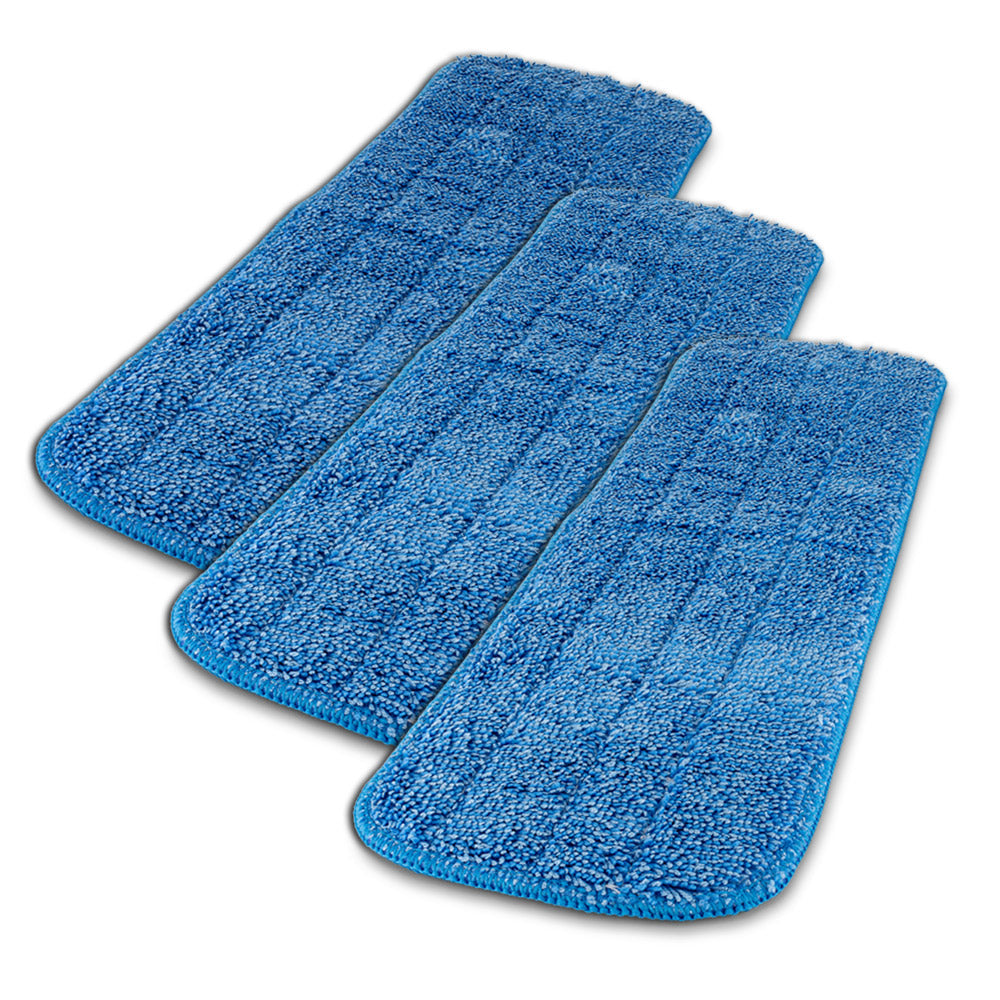What you will learn:
- The different types of mops available
- The best way to clean hardwood floors without damaging them
- How to keep hardwood floors cleaner for longer

What you will learn:
So you’ve got hardwood floors and want to know the best way to clean them without damaging them?
You’ve come to the right place.
Hardwood floors are an excellent flooring option in just about any home. They're a fantastic investment for homeowners and landlords because:
Unlike some types of flooring, such as budget-friendly carpet and laminate that requires glues and adhesives, hardwood flooring is hypoallergenic and doesn’t emit any petrochemical emissions.
Best of all, they’re easy to clean with the right tools.
Should you even mop hardwood floors?
If you’re maintaining them by sweeping and vacuuming, shouldn’t that be enough?
Short answer, no. You still need to mop your hardwood floors. This doesn’t mean you need to saturate them, we’ll explain why later, but you need to clean them with water and high-quality tools, and we’ll explain why.
Hardwood flooring is more porous than other types of flooring and can accumulate dirt and debris in the tiny crevices and cracks that are invisible to the naked eye.
Any movement from foot traffic and furniture can create abrasive friction over leftover debris, damaging the surface of your hardwood floors.
So, although you may be sweeping or vacuuming regularly, the remaining particles you are likely to miss can cause wear and tear on the hardwood’s finish, degrading its appearance and durability.
It’s not only dirt and debris that can accumulate, either. An unmopped hardwood floor is a harbor for dust and germs.
To keep your family safe from allergies and bacteria, mopping your hardwood floors is critical. But there are different types of mops available on the market that are more suitable for hardwood floors, so let’s dive in and discuss them.
And if you also happen to have laminate flooring that needs cleaning, be sure to check out our guide on how to deep clean laminate floors.
Before you dive in to the types of mops for hardwood floors, let’s go over two of the worst tools for cleaning hardwood floors.
Brooms
Brooms have been around for centuries, are used all over the world, and can be found in just about every home. But just because they’re popular, doesn’t mean they’re effective.
When it comes to maintaining hardwood floors, they’re the least effective and least thorough method available.
There are two things that make brooms ineffective at maintaining hardwood floors:
Though they are effective for collecting larger debris, such as large pieces of broken glass, or cleaning up dry spills.
We’ve all owned a vacuum cleaner before.
The most popular styles are the upright, canister, and stick vacuums, all of which usually have a beater bar—that rotating bristle brush.
But the best vacuum for hard surface floors shouldn’t have a beater bar as this will damage your hardwood floor. And even though there are vacuums that are designed for hardwood floors, they’re not the best method of cleaning hardwood.
There are several problems with using a vacuum to clean hardwood floors:
"I have 2400 square feet of hand scraped hardwood floors and have tried various microfiber mops. The cheaper mops do not seem to pick up the dirt that collects in the valleys of the hand scraped floors. This mop is much thicker and does an excellent job. I highly recommend this mop." - Penney Ahlstrom, Verified Customer
There are five types of mops that are most commonly used for mopping hardwood floors. In this section, we’ll highlight each one and show you the best mop type to use on hardwood floors and why.
The six most common types of mops are:
You may have seen and maybe even used a sponge mop before.
Made from either cellulose, rubber, or plastic foam, these squishy sponges are connected to a plastic or metal handle. The handle typically doesn’t extend, so you have to do a lot of bending to use it.
The sponge isn’t very absorbent and doesn’t lift or trap dirt and debris effectively. So what ultimately ends up happening is that the sponge moves everything around rather than trapping and absorbing it, spreading germs and bacteria.
The sponge mop is not recommended for hardwood floors because:
The string wet mop is the oldest style of mop that exists.
Maybe you remember your mother or grandmother using one of these at home. They’re typically made from cotton rope strands with or without looped ends.
The fibers are generally absorbent but must be wrung out regularly throughout mopping, otherwise, they stop absorbing particles and start spreading them instead.
Just as the sponge mops may do, germs and allergens don’t get properly washed away, creating a haven for bacteria to thrive.
Although the string wet mop is the OG of mops and is still used widely today, there are several problems with using one on hardwood floors:
"This is the most AWESOME product... and I don't even use the word awesome for anything. I can't believe it's taken me 60 years to find this. It is incredibly sturdy, doesn't flip pushing or pulling, can handle some incredible elbow grease from the human operating it, and is adjustable for short person like myself. The mop head is very substantial, attaches amazingly securely, doesn't slip or budge in the least, extends out from the mop base so you can clean right up against woodwork and appliances and never have to worry about scratching or marring anything." - Lisa, Verified Customer
The newest kid on the block, and possibly the most problematic, is the Swiffer Mop. This guy became popular in recent years because of its convenience.
The Swiffer Mop is typically made from plastic components. You attach a single-use pad to the base and dispose of it once you’re done. These pads can usually only do a small area before it becomes noticeably dirty, stopping it from doing a decent job.
It usually has a container of floor cleaner attached to the handle and a trigger button at the top that releases the liquid in front of the Swiffer Mop.
This convenient contraption sounds like the perfect floor cleaning device. But there a quite a few reasons why a Swiffer Mop is not recommended for hardwood floors, or most floors, for that matter.
Another newer style of mop is the Spin Mop. What makes this mop unique is that, instead of the traditional wringing out or squeezing the mop head, you place it inside the bucket’s basket, and using the foot pedal, spin the basket to flick excess liquid from the mop.
The mop head is usually made from microfiber, but it’s not always high quality. Though, it is a much easier way to remove water from the mop. But it’s not the best mop for hardwood floors, and here’s why:
Using a conventional broom to sweep up dust and debris is ineffective, always leaving particles and dust behind. One of the best ways to collect dust, dirt, and debris is to use a cotton blend dust mop.
These mops have been around since the mid-20th century, and are still widely used residentially and commercially. The pad is usually made from a blend of cotton and synthetic fibers and is machine-washable. The handle is sometimes telescopic, depending on the brand, making it more ergonomical.
The mop fibers do a great job of collecting soil, making it easy and efficient to get the job done.
However, using a cotton blend dust mop has a few downsides.
The last mop on our list of most commonly used mops is the Microfiber Mop. This is by far the most superior type of mop for any surface, particularly hardwood floors.
Microfiber typically has more density of fibers, or GSM (grams per square meter), than other mop types. This gives microfiber the ability to grip onto soils and particles more effectively.
High-quality microfiber can also be positively charged, which acts as a magnet, attracting and trapping negatively charged dust and debris.
It’s highly absorbent, and perfect for mopping up spills. And many microfiber mop pads are more durable and can be machine washed hundreds of times without losing their integrity.
There’s good reason why most cleaning and healthcare professionals choose to use microfiber to clean.
There are several kinds of microfiber mops on the market, but a microfiber flat mop will be the best mop to use on your hardwood floors. Here’s why:
"After much research, I purchased this mop system. When it arrived it was higher quality than expected, heavy duty and a snap to assemble. It is adjustable for your height/comfort, has an awesome Velcro system to attach the microfiber pads and I can not believe how well it cleans my ceramic tile and hardwood floors. I could not be happier with this product and highly recommend it." - T.Trueblood, Verified Customer
The best microfiber flat mop for hardwood floors is the Professional Microfiber Mop System.
This mop system is a complete solution for not just hardwood floors but all types of floors, such as tiles, concrete, laminate, and stone.
With a telescopic handle extending over six feet tall, this mop is suitable for people short and tall. The frame can pivot 360° for easy maneuvering, and the pivot function can be locked so you can mop walls and other tricky spots.
The handle and frame are both made from lightweight and durable aluminum material. No more dragging around a bulky and heavy vacuum cleaner or mop bucket.
The Professional Microfiber Mop System includes a microfiber dust mop pad and microfiber wet mop pad. The dust mop pad does an incredible job of picking up dust and debris from hardwood floors.
Microfiber mop pads contain more fibers than conventional fiber mops, which means that they have more capacity to hold onto dirt and liquids.
Another crucial feature that gives microfiber its cleaning power is the shape of the fibers. The shape makes it act like a squeegee, scraping up and collecting dirt.
The dust mop pad has two types of microfiber; a soft center pad to dust and clean debris from the floor, and a looped fringe to grab onto dust particles from corners.
So as you swivel the mop around and underneath surfaces, you’ll easily and quickly grab every speck of dust it comes in contact with.
To top it all off, the Microfiber Mop Pads work effectively with just water, so you can ditch the chemicals. The pads are also 100% machine-washable, and can be reused hundreds of times. To find out more about how to care for your microfiber to get the most out of them, read this article.
We have three sizes available in our microfiber mops.
When mopping hardwood floors, knowing which tools to use to prevent damage and give them a clean they deserve is supreme. Keep your floors looking clean and incredible for many years to come.
Em Rey
Content Contributor at
Microfiber Wholesale

Em is an experienced content writer and strategist, creating engaging and informative content for lifestyle, home, and beauty publications over the past eight years.
Her passion for eco-friendly cleaning aligns with the growing demand for sustainable solutions, and she’s a strong advocate for microfiber products due to their efficiency and environmental benefits.
Em’s in-depth knowledge of the cleaning industry and commitment to promoting green initiatives make her an ideal partner for crafting content that resonates with professional cleaners.
When she’s not creating content, you'll find her with a toddler in tow either outdoors, somewhere near water, or baking.
 Save $-13.98
Save $-13.98
Get ready to clean like a pro with our Microfiber Wet Mop Pads. Trusted by cleaning professionals, these pads are the most effective and efficient ...
View full detailsCopyright © 2025 Microfiber Wholesale. All right reserved.

Promote your brand while protecting your towels from wandering off with our property marking service - an affordable and professional looking solution to keep your towels in service.
 By continuing with your order, you acknowledge and agree to the following:
By continuing with your order, you acknowledge and agree to the following:Our property-marked towels are printed with a repeating pattern, and logo placement may vary from towel to towel.
You’ve chosen between receiving an emailed digital proof for a detailed review of your design at an additional cost of $20, or allowing our print team to use your uploaded file to prepare your order for printing.
We do not accept returns for printed property marked towels.
